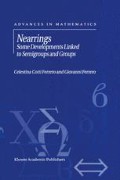Abstract
As in many mathematical subjects, a characterization of a class of objects is more precise and interesting if it can lead to construing all such objects, in particular, when the obtained constructions can also help to find other properties of the objects or to give a more detailed classification of them. Conversely, a construction itself can help to define new and maybe interesting objects to be further studied (and maybe, construed with a smarter technique).
The first natural idea to construe nearrings is to choose an additive group [G; +] and try to define a product fulfilling required properties, also because many mathematicians are acquainted with elementary group theory. Even more simple is to start from the additive group of a vector space (or even from a vector space V) because, in this case, linear transformations (that are particular endomorphisms of [V; +]) are immediately at our disposal, and can be used as Clay functions. Also, to give an example of using this idea (and to not be too heavy writing down complex conditions), we open the chapter with a construction of an interesting local nearring and (in a very simplified form) of a nearring that forth arouses in a framework that is a bit further away from the usual nearringers’ studies.
We can read as a generalization of the previous ideas some constructions obtained by starting from a direct (or semidirect) sum of additive groups; some of them can be obtained by “composition” of other nearrings using variations of classical compositions of additive groups or of multiplicative semigroups.
As usual, only the simpler remarks are given, to be also used as examples of natural techniques.
The first section of this chapter closes with a more sophisticated construction of a group-theoretical source, pointing out some nearrings fulfilling peculiar properties.
The second section is devoted to the analysis of certain nearrings arising from the theory of automata: they are examples of the idea of define a nearring [N; +, ·] starting from a group [G; +] and defining a product by xy = α(x) + β(y) for suitable functions α, β from G to G.
To go deeper into the study of nearrings with a given additive group [G; +] obtained by gluing “partial” Clay functions obtained using few endomorphisms of G, it is suggested to study generalized orbits of a semigroup of endomorphisms of an additive group. Some applications of this idea are given in construing, for example, nearrings whose Clay semigroup is a given infinite cyclic semigroup with zero added.
This leads to an important theorem (BFKL) which teaches us to construe, under suitable (not so elegant) conditions, nearrings with a given additive group and a given Clay semigroup. This theorem is the key point of the section (and of the chapter) because it is followed by variations and applications of great interest. In fact, perhaps, it was given to find the groups hosting nontrivial nearrings (and it is close to solving the problem), but (with its many variants), it can also be used to construe and classify many other classes of nearrings. Here it is used for a little study on planar and integral nearrings also.
The last section is devoted to (sometimes trivial) various techniques that may be used to obtain nearrings “deforming” operations of other structures (a Dickson’s idea), and also to generalize some of the results previously written as a preparation of the BFKL theorem: after such theorem, we are free to treat certain questions, even if such theorem is not explicitly used. Another idea stressed in this section is the Magill “lamination.” We introduce it, but we avoid the topological considerations from which such idea arose.
Man muss immer umkehren.
—Jacobi (1804–1851)
Access this chapter
Tax calculation will be finalised at checkout
Purchases are for personal use only
Preview
Unable to display preview. Download preview PDF.
Author information
Authors and Affiliations
Rights and permissions
Copyright information
© 2002 Kluwer Academic Publishers
About this chapter
Cite this chapter
Ferrero, C.C., Ferrero, G. (2002). Constructions. In: Nearrings. Advances in Mathematics, vol 4. Springer, Boston, MA. https://doi.org/10.1007/978-1-4613-0267-4_2
Download citation
DOI: https://doi.org/10.1007/978-1-4613-0267-4_2
Publisher Name: Springer, Boston, MA
Print ISBN: 978-1-4020-0875-7
Online ISBN: 978-1-4613-0267-4
eBook Packages: Springer Book Archive

